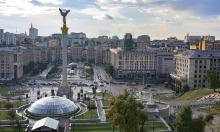Landing of Genesis space capsule
A daring plan to have helicopters snag a space capsule as it plunged toward Earth went awry yesterday when its parachutes failed to open and it slammed into the desert floor. The catastrophic descent left the Genesis capsule buried halfway underground and exposed its collection of solar atoms to contamination. The capsule held billions of atoms collected from the solar wind during a mission that was designed to reveal clues about the origin and evolution of the solar system. Scientists were hopeful they could salvage the broken disks that held the atoms, and perhaps still unravel the mystery of the solar system. “This is actually not the worst-case scenario,” said Andrew Dantzler, director of NASA’s solar system division, noting the capsule embedded itself in soft desert soil and avoided hitting anything harder that would have made it a “total loss.” Flight engineers suspect a set of tiny explosives failed to trigger the capsule’s parachutes, and the capsule slammed into the Utah desert at 310 km/h, reports Fort Frances Times Online. According to Sun Fransisco Chronicle, the Genesis space capsule and its precious cargo -- billions of particles from the sun -- crashed into the Utah desert Wednesday in a last-minute bungling of a near-flawless, three-year scientific odyssey. Because of what apparently was a parachute failure, the $260 million space probe didn't slow down as it entered Earth's atmosphere Wednesday morning. Tumbling end over end, Genesis smashed into a desert bombing range at 193 mph at Dugway Proving Ground, Utah. Shaken NASA officials immediately began the tedious process of recovering the capsule. They hope to salvage the probe's unique scientific data: roughly a billion billion (1 to the 18th power) particles from the deep-space "solar wind," a continual gale of electrically charged atomic fragments. But the recovery will take time -- and extreme caution -- because the capsule probably contains unexploded ordnance that was to have been set off during re-entry, unleashing the parachute. It failed to do so for reasons not yet known. The capsule had returned to Earth from its orbit around the sun at 25,000 mph, officials said, and entered the Earth's atmosphere at 8:53 a.m. Two minutes later, the drogue was to be activated. The capsule crashed to the ground at 8:59 a.m. at 193 mph, said Ed Hirst, Genesis mission manager for JPL. "The last time we had contact with the capsule, everything was per planned," Hirst said. "We knew the instant the drogue didn't appear that something was wrong." The next step is to salvage whatever science wasn't contaminated by the impact. "It's important to underscore that the science all returned to Earth," Gentry Lee, chief engineer for planetary systems at JPL, said in Pasadena. "It may not have been the way we wanted, but it's here", publishes PE.
Read earlier news stories by PRAVDA.Ru
Subscribe to Pravda.Ru Telegram channel, Facebook, RSS!





